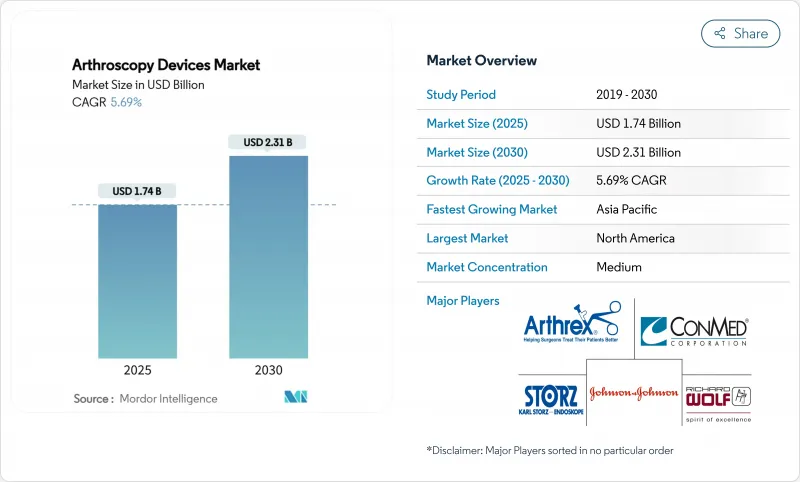
|
市場調査レポート
商品コード
1851559
関節鏡検査機器:市場シェア分析、産業動向、統計、成長予測(2025年~2030年)Arthroscopy Devices - Market Share Analysis, Industry Trends & Statistics, Growth Forecasts (2025 - 2030) |
||||||
カスタマイズ可能
適宜更新あり
|
|||||||
| 関節鏡検査機器:市場シェア分析、産業動向、統計、成長予測(2025年~2030年) |
|
出版日: 2025年07月22日
発行: Mordor Intelligence
ページ情報: 英文 116 Pages
納期: 2~3営業日
|
概要
関節鏡検査機器の市場規模は、2025年に17億4,000万米ドル、2030年には23億1,000万米ドルに達し、CAGR 5.69%で成長すると予測されています。

需要の加速は、低侵襲な関節修復への継続的なシフト、筋骨格系疾患の有病率の着実な上昇、外来手術経路の採用拡大を反映しています。機器メーカーは現在、可視化、切除、インプラントシステムをバンドルし、手技1回当たりの価値を高めています。人工知能ガイダンス、ワイヤレス画像処理、バイオインテグレーティブ・インプラントは、臨床的有効性と価格決定力の両方を高めています。同時に、持続可能性規制と使い捨ての精査が、リサイクル可能なポートフォリオやハイブリッド・ポートフォリオの研究を刺激します。競合戦略は、画期的な技術の確保や地理的ギャップを埋める買収に集中し、セクターの統合は緩やかなゾーンにとどまる。
世界の関節鏡検査機器市場の動向と洞察
筋骨格系障害の負担増
世界の変形性関節症の患者数は2021年に6億650万人に達し、有病率は女性と高齢者の間で加速しています。筋骨格系疾患は現在、障害を伴う生活年数の第2位の原因となっており、支払者は費用対効果の高い関節鏡ソリューションへと向かっています。予測によると、2045年までに閉経後の女性の50%近くが変形性関節症に罹患する可能性があります。従って、需要の伸びは、先進国、新興国の両方における人口動態の高齢化と平均寿命の伸びに直接合致します。
低侵襲整形外科手術へのシフト
関節鏡手術が開腹手術に取って代わると、平均在院日数が2~3日短縮され、支払者の負担軽減と患者の満足度向上につながります。4K映像、ワイヤレスカメラ、ロボット支援により、かつてはポータルアプローチでは複雑すぎると考えられていた適応が拡大され、さらに普及が促進されます。若い患者には、開腹手術に比べてリハビリが早く、傷跡が小さいことが好まれています。
高い資本コストと手技コスト
完全装備の関節鏡室は50万米ドル以上の初期投資を必要とし、消耗品は1症例あたり2,000~5,000ドル追加されるため、症例数がそれほど多くない施設は圧迫されます。複数の関節をカバーする場合、在庫需要は増大し、払い戻しでは使い捨て消耗品の割高感を相殺できないことが多いです。
セグメント分析
膝関節の手術は2024年の売上の45.23%を占め、この関節の傷害発生率の高さ、関節鏡視下ACLおよび半月板修復プロトコルの成熟度を物語っています。安定した保険償還と外科医が熟知していることが、この手術件数を牽引しています。股関節鏡検査は、現在では規模が小さいもの、若年層のアスリートにおける大腿骨寛骨臼インピンジメントと関節唇断裂の認知が広まり、CAGR 7.67%で成長しています。アクセス精製カニューレとフレキシブルバリが、急峻な学習曲線を緩和し、この分野をより多くの地域病院に開放しています。肩と肘のスコープは、再断裂率を下げる生体誘導性パッチインプラントから恩恵を受け、内視鏡脊椎ポータルは、各社が椎間板減圧術にプラットフォームを拡大するにつれて、主流になりつつあります。全体として、手技構成は診断的洗浄から再建的修復へとシフトしており、このシフトが関節鏡検査機器市場全体の平均販売価格を引き上げています。
膝関節インターベンションの関節鏡検査機器市場規模は、スポーツ関連の靭帯修復と変性半月板管理に支えられ、2030年まで着実に拡大すると予測されます。対照的に、股関節の手術は現在10%台半ばのシェアに過ぎないが、インプラント、ポンプ、可視化システムが関節深部の人間工学に適応するにつれて、関節鏡検査機器市場シェアは大幅に拡大すると予測されます。さまざまな関節の採用率があるため、メーカーは関節に特化したシェーバーや縫合糸通過器、固定アンカーへの投資を続け、カタログやサービスモデルの細分化を強化しています。
地域分析
北米は2024年の売上高の42.43%を占め、高いトレーニング能力、強力な保険適用、高齢になっても体を動かす人口に支えられています。米国では、メディケアの3.8%の外来患者料金の更新が、ASCへの移行を促進しながら病院のマージンを維持しています。カナダの単一支払いモデルは年間手術件数を安定させ、メキシコの成長する医療観光市場は低価格の関節鏡手術を求める患者を引き寄せる。
欧州は、厳しい規制と熟練した外科医の大規模な基盤のバランスをとりながら、売上高で2位にランクされています。より環境に優しい機器を求めるEUの動きは、再利用可能なシェーバーハンドピースやリサイクル可能なチューブの早期採用を促しています。高齢化社会は、股関節と肩関節の手術件数を増加させ、国家的なスポーツ・プログラムは、膝関節のスコープを若い世代に普及させています。臨床結果エビデンスの要件は、サプライヤーとプロスペクティブレジストリーを運営する学術センターとの緊密な連携を促進し、関節鏡検査機器市場のデータコアを強化しています。
アジア太平洋地域はCAGR 6.54%で最も急成長している地域です。中国の集中購買によりインプラントの価格が下がり、病院への普及が進みます。国内OEMが台頭しているが、国際ブランドは4K可視化とナビゲーションで技術的優位性を保っています。日本のロボット工学のリーダーシップがAIガイド付きポータルの展開を支え、超高齢化社会が安定した症例増加を保証します。インドの官民パートナーシップは新しい関節鏡ラボに資金を提供し、政府のメイク・イン・インド政策は輸入関税を引き下げるために現地組立に拍車をかける。東南アジア諸国は民間保険の適用を拡大し、急成長する中産階級における膝関節鏡手術の需要を喚起しています。合わせて、可処分所得の上昇と病院の収容能力の向上が、関節鏡検査機器市場全体の持続的な台数増加につながります。
その他の特典:
- エクセル形式の市場予測(ME)シート
- 3ヶ月間のアナリストサポート
よくあるご質問
目次
第1章 イントロダクション
- 調査の前提条件と市場の定義
- 調査範囲
第2章 調査手法
第3章 エグゼクティブサマリー
第4章 市場情勢
- 市場概要
- 市場促進要因
- 筋骨格系障害の負担増
- 低侵襲整形外科手術へのシフト
- 関節鏡機器の絶え間ない技術革新
- スポーツとフィットネス活動への参加の増加
- 外来手術センターと外来患者の拡大
- 新興国におけるヘルスケア支出の増加
- 市場抑制要因
- 高い資本コストと手続きコスト
- 厳しい規制と償還のハードル
- 熟練した関節鏡視下手術医の限られた入手可能性
- シングルユース機器に関する持続可能性への懸念
- 規制情勢
- ポーターのファイブフォース分析
- 新規参入業者の脅威
- 買い手の交渉力
- 供給企業の交渉力
- 代替品の脅威
- 競争企業間の敵対関係
第5章 市場規模と成長予測
- 用途別
- 膝関節鏡検査
- 肩・肘関節鏡検査
- 股関節鏡検査
- 脊椎関節鏡検査
- 足関節鏡検査
- 手関節鏡検査
- その他の用途
- 製品別
- 関節鏡(リユーザブル&シングルユース)
- 関節鏡インプラント
- 可視化システム
- 流体管理システム
- RFアブレーションシステム
- 電動シェーバーと切除システム
- ハンド器具
- その他の製品
- エンドユーザー別
- 病院
- 外来手術センター(ASCs)
- 整形外科&スポーツ医学クリニック
- 地域
- 北米
- 米国
- カナダ
- メキシコ
- 欧州
- ドイツ
- 英国
- フランス
- イタリア
- スペイン
- その他欧州地域
- アジア太平洋地域
- 中国
- 日本
- インド
- オーストラリア
- 韓国
- その他アジア太平洋地域
- 中東・アフリカ
- GCC
- 南アフリカ
- その他中東・アフリカ
- 南米
- ブラジル
- アルゼンチン
- その他南米
- 北米
第6章 競合情勢
- 市場集中度
- 市場シェア分析
- 企業プロファイル
- Arthrex Inc.
- Smith & Nephew PLC
- Stryker Corporation
- Johnson & Johnson(DePuy Synthes)
- Conmed Corporation
- Zimmer Biomet Holdings Inc.
- Medtronic PLC
- Karl Storz SE & Co. KG
- Olympus Corporation
- Richard Wolf GmbH
- Cannuflow Inc.
- Ceterix Orthopaedics
- Wright Medical Group N.V.
- Bioventus Inc.
- Parcus Medical
- JRF Ortho
- Fujifilm Holdings Corp.
- Aesculap(B. Braun)
- G2 Orthopedics

